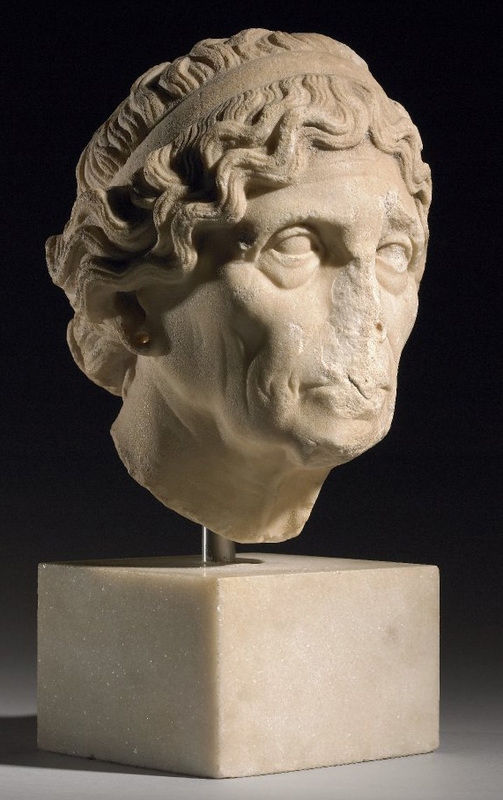Head of Lysimache
Title
Head of Lysimache
Date
4th Century BC (date of original), Hellenistic Period
Artist or Workshop
Unknown (Sometimes accredited to Demetrios of Alopeke)
Materials
Marble
Height of the work
35.7 cm tall
Provenience
Tarquinia, Viterbo (province), Lazio, Italy
Current Location
The British Museum of London, United Kingdom
Description and Significance
Description:
The head depicted here is that of a older female. It is approximately two-thirds life size and is supported by a bronze rod. She has heavy bags under her eyes, crows feet, and smile lines; additionally, the skin of her neck sags. The eyes are hooded and the mouth is straight. There is heavy damage to her nose, the left ear, and the mouth and some damage to the chin, the left eye, and the left eyebrow. The lobe of the right ear is pierced; this hole has a somewhat large diameter. The hair is stylized symmetrically and is wavy. It is bunched up at the nape of the neck. A plain headband keeps the elaborate hairstyle in place; this was called a strophion at the time.
Significance:
This portrait is significant because the original was a representation of the priestess of Athena. As mentioned in the description, wrinkles are quite prominent on this work; verism is used quite liberally by the artist. Wisdom and legacy are rendered through this depiction of age, as well as realism and individualism in depicting the priestess. Scholars indicate that Lysimache was priestess of Athena for sixty-four years; her lifelong service to Athena was something that the artist rendered through this use of verism. It should be noted that some scholars claim that the Greek original was made of bronze instead of marble.
It should be noted that Demetrios of Alopeke, the artist sometimes accredited for this work, was working in an anti-classical way; this can be discerned through the lack of idealization in the face.
The hole in her ear was likely home to an earring made of precious stone to indicate status through wealth. Furthermore, her headband was similar to the 3rd century marble portrait of the priestess Aristonoë from Rhamnous, indicating style trends in the Hellenistic period.
Although many scholars do believe this head to be that of Lysimache, this assumption is not universal or fact; the figure's identity is debated. Whether or not she represents Lysimache has yet to be proven, hence why some scholars remain skeptical.
The head depicted here is that of a older female. It is approximately two-thirds life size and is supported by a bronze rod. She has heavy bags under her eyes, crows feet, and smile lines; additionally, the skin of her neck sags. The eyes are hooded and the mouth is straight. There is heavy damage to her nose, the left ear, and the mouth and some damage to the chin, the left eye, and the left eyebrow. The lobe of the right ear is pierced; this hole has a somewhat large diameter. The hair is stylized symmetrically and is wavy. It is bunched up at the nape of the neck. A plain headband keeps the elaborate hairstyle in place; this was called a strophion at the time.
Significance:
This portrait is significant because the original was a representation of the priestess of Athena. As mentioned in the description, wrinkles are quite prominent on this work; verism is used quite liberally by the artist. Wisdom and legacy are rendered through this depiction of age, as well as realism and individualism in depicting the priestess. Scholars indicate that Lysimache was priestess of Athena for sixty-four years; her lifelong service to Athena was something that the artist rendered through this use of verism. It should be noted that some scholars claim that the Greek original was made of bronze instead of marble.
It should be noted that Demetrios of Alopeke, the artist sometimes accredited for this work, was working in an anti-classical way; this can be discerned through the lack of idealization in the face.
The hole in her ear was likely home to an earring made of precious stone to indicate status through wealth. Furthermore, her headband was similar to the 3rd century marble portrait of the priestess Aristonoë from Rhamnous, indicating style trends in the Hellenistic period.
Although many scholars do believe this head to be that of Lysimache, this assumption is not universal or fact; the figure's identity is debated. Whether or not she represents Lysimache has yet to be proven, hence why some scholars remain skeptical.
References
The British Museum
Breckenridge, James D. Likeness. 1968. Pages 98-101.
Dillon, Sheila. The female portrait statue in the Greek world. Cambridge University Press, 2010. Page 14.
Hekler, Antal. Greek & Roman Portraits. W. Heinemann, 1912. Page X.
Keesling, Catherine M. "SYERIS, DIAKONOS OF THE PRIESTESS LYSIMACHE ON THE ATHENIAN ACROPOLIS (IG II2 3464)." hesperia 81.3 (2012). Page 498.
Breckenridge, James D. Likeness. 1968. Pages 98-101.
Dillon, Sheila. The female portrait statue in the Greek world. Cambridge University Press, 2010. Page 14.
Hekler, Antal. Greek & Roman Portraits. W. Heinemann, 1912. Page X.
Keesling, Catherine M. "SYERIS, DIAKONOS OF THE PRIESTESS LYSIMACHE ON THE ATHENIAN ACROPOLIS (IG II2 3464)." hesperia 81.3 (2012). Page 498.
Contributor
Charlotte Myers
Citation
Unknown (Sometimes accredited to Demetrios of Alopeke), “Head of Lysimache,” Digital Portrait "Basket" - ARTH488A "Ancient Mediterranean Portraiture", accessed April 24, 2025, http://classicalchopped.artinterp.org/omeka/items/show/25.
Item Relations
This item has no relations.

